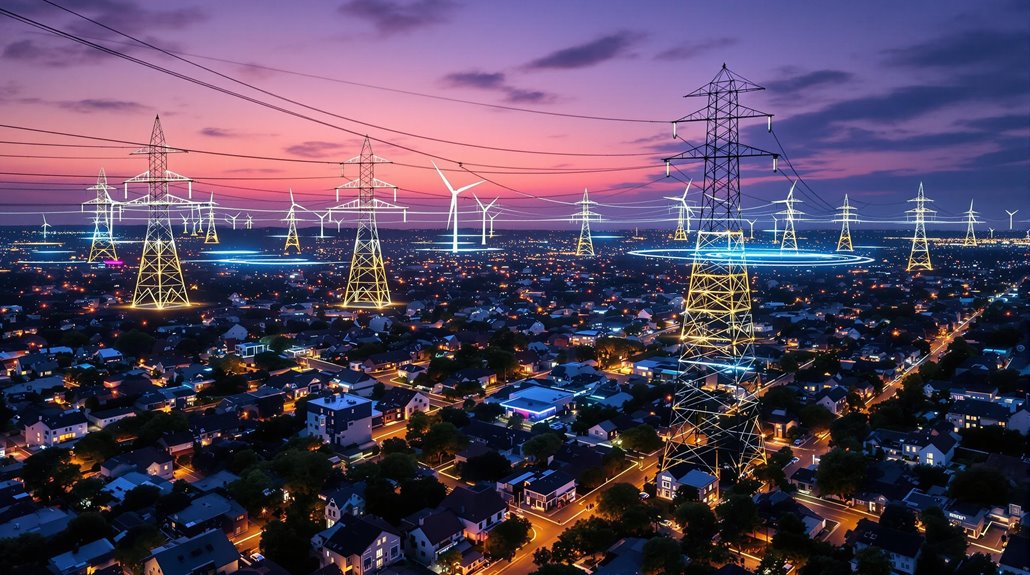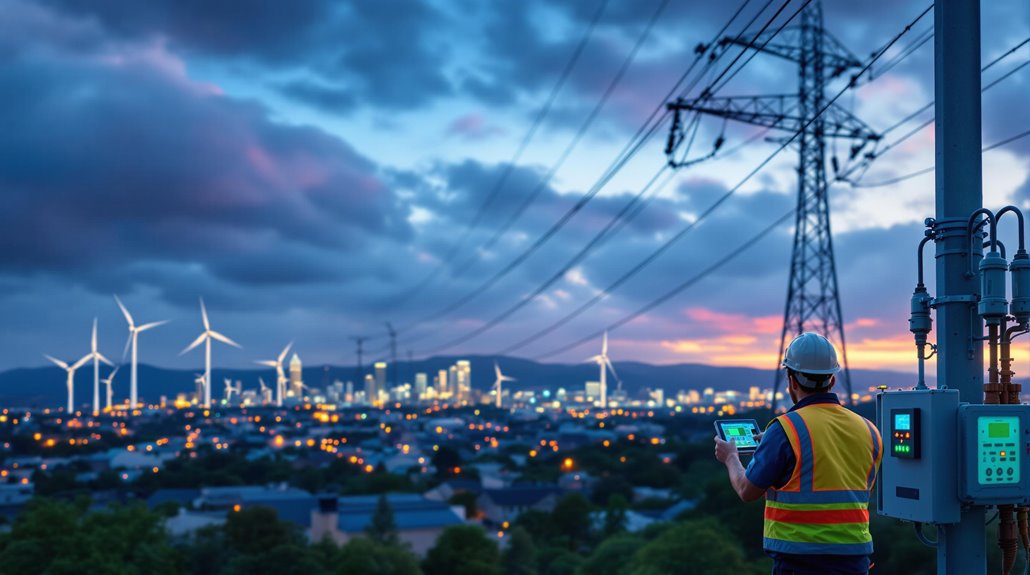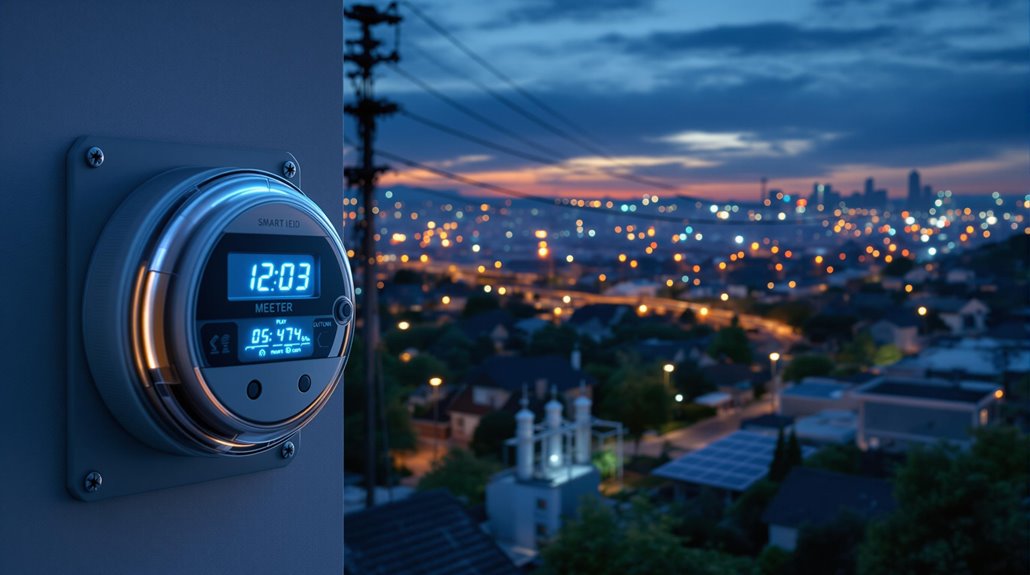What Is a Smart Electrical Grid?

A smart electrical grid uncovers your traditional power system into an intelligent network that uses advanced technology for two-way communication between utilities and consumers. You'll benefit from enhanced reliability, lower costs, and better integration of renewable energy sources through real-time monitoring and automated control systems. Modern smart grids can reduce your electricity costs by up to 10% while supporting 50% more renewable energy. There's much more to explore about this revolutionary power infrastructure.
The Evolution of Power Distribution
How did our modern electrical grid evolve from its humble beginnings? In the 20th century, you'd find a simple, one-way system that delivered electricity from large power plants to your home. The grid expanded rapidly, connecting more communities and becoming increasingly complex by the late 1960s.
As demand grew and technologies advanced, the traditional power distribution system needed an upgrade. The introduction of smart meters in the 1980s marked the first step toward reconfiguration, followed by advanced metering systems in the 1990s. Today's smart grids represent a complete alteration of that original system, enabling two-way communication between utilities and consumers.
This evolution has made it possible to integrate renewable energy sources, optimize electricity distribution, and respond to changing demand patterns in real-time. The modernization of the grid has also improved the management of reactive power, which is essential for maintaining stable voltage levels throughout the distribution network.
Core Components of Smart Grid Technology
A modern smart grid consistently relies on five essential components working in harmony to modify how we manage electricity. You'll find that these smart grid technologies convert traditional power grid operations into an intelligent electricity grid focused on efficiency and reliability.
The grid infrastructure incorporates advanced systems that enable real-time monitoring and control of energy distribution and consumption. Through smart meters and SCADA systems, you're able to participate in demand response programs while utilities can better manage the electrical grid.
Emergency lighting systems require reliable backup power integration within smart grid infrastructure to maintain safety compliance during outages.
- Advanced sensors and communication networks that enable real-time data exchange
- Intelligent metering systems that provide two-way communication between you and utilities
- Automated control systems that optimize power flow and respond to grid conditions
- Distributed energy resources integration, allowing for decentralized power generation and storage
Each component works together to create a more resilient and efficient energy future.
Benefits of Smart Grid Implementation

The implementation of smart grid technology delivers substantial benefits across multiple sectors, altering how we generate, distribute, and consume electricity. You'll see improved energy conservation through optimized power distribution, reducing losses by up to 15% while enhancing reliability by 30% through advanced control systems.
Smart grids alter electricity grids by supporting 50% more renewable energy sources, helping power plants shift away from fossil fuels. The technology gives you real-time visibility into your energy usage, enabling smarter consumption decisions that can cut your electricity costs by 10%. Additionally, these modernized systems balance energy supply and demand more effectively through automated monitoring and rapid response capabilities.
The electric power industry's evolution through smart grid implementation isn't just environmental - it's also creating significant economic opportunities, with projections showing one million new jobs by 2030. Unlike traditional power systems that rely solely on alternating current (AC) transmission, smart grids can efficiently manage both AC and DC power sources to maximize energy distribution across long distances.
Real-Time Data Management and Communication
Smart meters and sensors form the digital nervous system of modern electrical grids, collecting and transmitting data in real time across vast networks. These advanced systems utilize sensor networks and SCADA systems to monitor electricity demand and energy consumption patterns continuously. Through standardized communication protocols, you'll find seamless integration of various grid components that enable efficient data exchange between utilities and consumers.
- IoT devices and cloud computing platforms provide enhanced visibility into grid operations
- Real-time data analytics help predict and manage power distribution more effectively
- Automated systems process vast amounts of information to detect and respond to grid issues
- Smart grids use artificial intelligence to optimize energy flow and reduce waste
This sophisticated data management infrastructure allows utilities to make informed decisions quickly, ensuring reliable power delivery while maintaining grid stability and efficiency. The system effectively manages both alternating current and direct current power sources to ensure optimal distribution across the network.
Renewable Energy Integration Capabilities

Building on the strong data management foundation, modern electrical grids now excel at incorporating renewable energy sources into existing power networks. Smart grids use advanced algorithms to seamlessly manage power transmission from intermittent sources like solar and wind, ensuring reliable grid integration. Through sophisticated energy storage systems and demand response programs, you'll find these power systems can effectively balance supply fluctuations.
The grid modernization process enables distributed generation, where you can become an active participant in the power system. You're no longer just consuming electricity - you can now generate and sell excess renewable energy back to the grid. This two-way flow, combined with enhanced energy efficiency measures, creates a more sustainable power infrastructure. Smart grids are reshaping our energy landscape by making large-scale renewable adoption both practical and efficient.
Smart Grid Security Measures
Given the critical nature of power infrastructure, protecting smart grids against cyber and physical threats requires multiple layers of sophisticated security measures. You'll find comprehensive cybersecurity systems that use encryption, access controls, and anomaly detection to safeguard your power supply. Grid-edge security protects devices and sensors, while robust communication protocols and network segmentation contain potential breaches.
- Regular software updates patch vulnerabilities and strengthen system defenses
- Incident response plans enable quick action when security events occur
- Physical security measures like surveillance and access restrictions protect essential infrastructure
- Employee training confirms everyone follows cybersecurity best practices
These integrated security measures work together to defend smart grids against changing threats, keeping your power supply reliable and secure while protecting sensitive grid data from unauthorized access.
Economic Impact and Cost Savings

The economic advantages of modernized power grids reach far beyond basic infrastructure improvements. Smart grids offer substantial cost savings for both consumers and grid operators through enhanced monitoring capabilities and efficient electricity distribution. You'll see lower energy costs thanks to real-time power consumption tracking and optimized energy use.
The transmission and distribution system benefits are significant, with utility companies saving billions in operational expenses through improved asset management. When energy demand fluctuates, smart grids adjust automatically, reducing power outage risks that currently cost the U.S. economy up to $70 billion annually. The integration of renewable sources creates additional long-term savings compared to traditional power generation. By 2050, these modernized systems could generate $2 trillion in global benefits through reduced emissions and enhanced grid efficiency.
Global Smart Grid Initiatives
Worldwide investments in smart grid technology have reached extraordinary levels, with major economies committing over $800 billion to modernize their power infrastructure. You'll see unparalleled changes in electrical infrastructure as nations race to upgrade their power systems for better energy flow and demand-supply balance.
- The EU's €170 billion investment focuses on grid digitalization to enhance renewable energy integration
- China's $442 billion commitment aims to revolutionize its electricity network with smart grid technologies
- Japan's $155 billion program accelerates the deployment of advanced power systems
- India's $38 billion scheme targets improvements in distribution infrastructure
These initiatives reflect a global push toward grid modernization, enabling more efficient power distribution and supporting the shift to renewable energy. You'll benefit from improved reliability, reduced costs, and enhanced grid performance as these smart grid technologies become standardized worldwide.
Challenges in Smart Grid Adoption
Despite significant global investments, implementing smart grid technologies faces numerous technical and operational challenges. You'll find that aging infrastructure poses a major hurdle, as existing transmission and distribution lines often can't support advanced technologies without substantial upgrades.
The implementation of smart systems requires seamless communication between the utility and consumers, which isn't always possible due to connectivity issues. You're also looking at challenges with data flow management, as smart grids generate massive amounts of information that must be processed and secured. The deployment of smart grid technology demands significant investment, which can slow down the rollout of smart meters and other components. Additionally, you'll need to guarantee reliable power delivery while maintaining cybersecurity, making the shift complex and time-consuming.
Future Developments and Innovations
Smart grid innovation continues to accelerate with breakthrough technologies reshaping power distribution systems. You'll see astonishing advancements in grid optimization through AI and machine learning, enabling better demand-side management and predictive maintenance. The future of electricity consumption relies heavily on advanced energy storage solutions to balance renewable energy intermittency.
- 5G networks will enable real-time data exchange, making smart grids more responsive and efficient
- Blockchain technology will revolutionize peer-to-peer energy trading, creating new opportunities for distributed energy resources
- Advanced storage technologies, including batteries and pumped hydro, will support grid resilience
- Smart microgrids will serve as testing grounds for innovative applications while strengthening local power distribution
These developments will alter how you interact with electricity, making power systems more efficient, sustainable, and reliable while supporting the integration of renewable energy sources.




